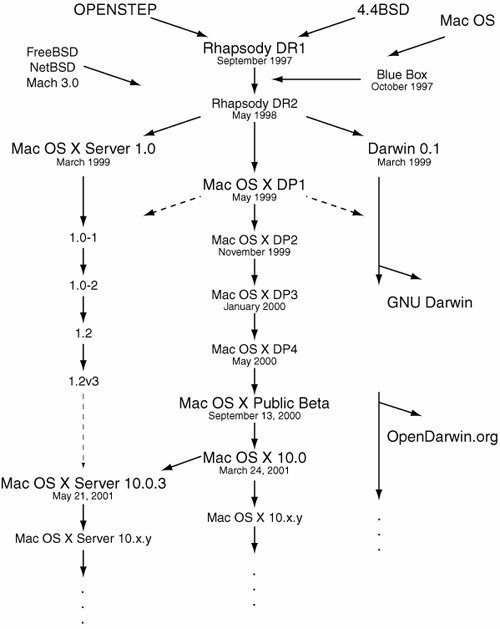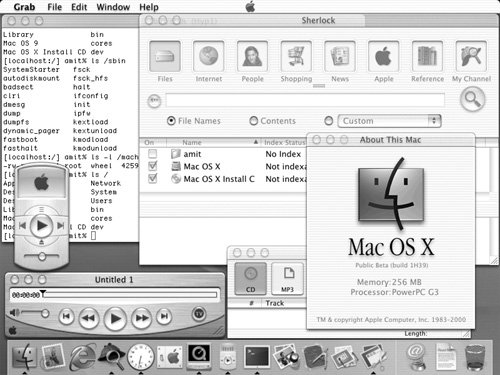Section 1.5. Toward Mac OS X
1.5. Toward Mac OS XAfter Rhapsody's DR2 release, Apple would still alter its operating system strategy but would finally be on its way toward achieving its goal of having a new system. During the 1998 Worldwide Developers Conference, Adobe's Photoshop ran on what would be Mac OS X. However, the first shipping release of Mac OS X would take another three years. Figure 111 shows an approximation of the progression from Rhapsody toward Mac OS X. Figure 111. An approximation of the Mac OS X timeline 1.5.1. Mac OS X Server 1.xAs people were expecting a DR3 release of Rhapsody, Apple announced Mac OS X Server 1.0 in March 1999. Essentially an improved version of Rhapsody, it was bundled with WebObjects, the QuickTime streaming server, a collection of developer tools, the Apache web server, and facilities for booting or administering over the network. Apple also announced an initiative called Darwin: a fork of Rhapsody's developer release. Darwin would become the open source core of Apple's systems. Over the next three years, as updates would be released for the server product, development of the desktop version would continue, with the server sharing many of the desktop improvements. 1.5.2. Mac OS X Developer PreviewsThere were four Developer Preview releases of Mac OS X, named DP1 through DP4. Substantial improvements were made during these DP releases. 1.5.2.1. DP1An implementation of the Carbon API was added. Carbon represented an overhaul of the "classic" Mac OS APIs, which were pruned, extended, or modified to run in the more modern Mac OS X environment. Carbon was also meant to help Mac OS developers transition to Mac OS X. A Classic application would require an installation of Mac OS 9 to run under Mac OS X, whereas Carbon applications could be compiled to run as native applications under both Mac OS 9 and Mac OS X. 1.5.2.2. DP2The Yellow Box evolved into Cocoa, originally alluding to the fact that besides Objective-C, the API would be available in Java. A version of the Java Development Kit (JDK) was included, along with a just-in-time (JIT) compiler. The Blue Box environment was provided via Classic.app (a newer version of MacOS.app) that ran as a process called truBlueEnvironment. The Unix environment was based on 4.4BSD. DP2 thus contained a multitude of APIs: BSD, Carbon, Classic, Cocoa, and Java. There was widespread dissatisfaction with the existing user interface. The Aqua user interface had not been introduced yet, although there were rumors that Apple was keeping the "real" user interface a secret.[23]
Carbon is sometimes perceived as "the old" API. Although Carbon indeed contains modernized versions of many old APIs, it also provides functionality that may not be available through other APIs. Parts of Carbon are complementary to "new" APIs such as Cocoa. Nevertheless, Apple has been adding more functionality to Cocoa so that dependencies on Carbon can be eventually eliminated. For example, before Mac OS X 10.4, much of the QuickTime functionality was available only through Carbon. In Mac OS X 10.4, Apple introduced the QTKit Cocoa framework, which reduces or eliminates Carbon dependencies for QuickTime. 1.5.2.3. DP3The Aqua user interface was first demonstrated during the San Francisco Macworld Expo in January 2000. Mac OS X DP3 included Aqua along with its distinctive elements: "water-like" elements, pinstripes, pulsating default buttons, "traffic-light" window buttons, drop shadows, transparency, animations, sheets, and so on. The DP3 Finder was Aqua-based as well. The Dock was introduced with support for photorealistic icons that were dynamically scalable up to 128x128 pixels. 1.5.2.4. DP4The Finder was renamed the Desktop in DP4. The System Preferences application (Preferences.appthe precursor to System Preferences.app) made its first appearance in Mac OS X, allowing the user to view and set a multitude of system preferences such as Classic, ColorSync, Date & Time, Energy Saver, Internet, Keyboard, Login Items, Monitors, Mouse, Network, Password, and others. Prior to DP4, the Finder and the Dock were implemented within the same application. The Dock was an independent application (Dock.app) in DP4. It was divided into two sections: the left side for applications and the right side for the trash can, files, folders, and minimized windows. Other notable components of DP4 included an integrated development environment and OpenGL.
The Dock's visual indication of a running application underwent several changes. In DP3, an application's Dock icon had a bottom edge a few pixels high that was color-coded to indicate whether the application was running. This was replaced by an ellipsis in DP4 and was followed by a triangle in subsequent Mac OS X versions. DP4 also introduced the smoke cloud animation that ensues after an item is dragged off the Dock. 1.5.3. Mac OS X Public BetaApple released a beta version of Mac OS X (Figure 112) at the Apple Expo in Paris on September 13, 2000. Essentially a publicly available preview release for evaluation and development purposes, the Mac OS X Public Beta was sold for $29.95 at the Apple Store. It was available in English, French, and German. The software's packaging contained a message from Apple to the beta testers: "You are holding the future of the Macintosh in your hands." Apple also created a Mac OS X tab on its web site that contained information on Mac OS X, including updates on third-party applications, tips and tricks, and technical support. Figure 112. Mac OS X Public Beta Although the beta release was missing important features and ostensibly lacked in stability and performance, it demonstrated several important Apple technologies at work, particularly to those who had not been following the DP releases. The beta's key features were the following:
With Darwin, Apple would continually leverage a substantial amount of existing open source software by using it forand often integrating it withMac OS X. Apple and Internet Systems Consortium, Inc. (ISC), jointly founded the OpenDarwin project in April 2002 for fostering cooperative open source development of Darwin. GNU-Darwin is an open source Darwin-based operating system.
1.5.4. Mac OS X 10.xThe first version of Mac OS X was released on March 24, 2001, as Mac OS X 10.0 Cheetah. Soon afterwards, the versioning scheme of the server product was revised to synchronize it with that of the desktop system. Since then, the trend has been that a new version of the desktop is released first, soon followed by the equivalent server revision. Table 11 lists several major Mac OS X releases. Note that the codenames are all taken from felid taxonomy.
Let us look at some notable aspects of each major Mac OS X release. 1.5.4.1. Mac OS X 10.0Apple dubbed Cheetah as "the world's most advanced operating system," which would become a frequently used tagline for Mac OS X.[24] Finally, Apple had shipped an operating system with features that it had long sought. However, it was clear that Apple had a long way to go in terms of performance and stability. Key features of 10.0 included the following:
When Mac OS X 10.0 was released, there were approximately 350 applications available for it. 1.5.4.2. Mac OS X 10.1Puma was a free update released six months after 10.0's release. It offered significant performance enhancements, as indicated by Apple's following claims:
There were substantial performance boosts in other areas such as system startup, user login, Classic startup, OpenGL, and Java. Other key features of this release included the following:
The Carbon API implementation in 10.1 was complete enough to allow important third-party applications to be released. Carbonized versions of Microsoft Office, Adobe Photoshop, and Macromedia Freehand were released soon after 10.1 went public. 1.5.4.3. Mac OS X 10.2Jaguar was released at 10:20 P.M. to emphasize its version number. Its important feature additions included the following:
Hereafter, Apple introduced new applications and incorporated technologies in Mac OS X at a bewildering pace. Other notable additions to Mac OS X after the release of Jaguar included the iPhoto digital photo management application, the Safari web browser, and an optimized implementation of the X Window System. 1.5.4.4. Mac OS X 10.3Panther added several productivity and security features to Mac OS X, besides providing general performance and usability improvements. Notable 10.3 features included the following:
1.5.4.5. Mac OS X 10.4Besides providing typical evolutionary improvements, Tiger introduced several new technologies such as Spotlight and Dashboard. Spotlight is a search technology consisting of an extensible set of metadata importer plug-ins and a query API for searching files based on their metadata, even immediately after new files are created. Dashboard is an environment for creating and running lightweight desktop utilities called widgets, which normally remain hidden and can be summoned by a key-press. Other important Tiger features include the following:
The first shipping x86-based Macintosh computers used Mac OS X 10.4.4 as the operating system. As we have seen in this chapter, Mac OS X is a long evolution of many disparate technologies. The next version of Mac OS X is expected to continue the remarkable pace of development, especially with the transition from the PowerPC to the x86 platform. In Chapter 2, we will take a diverse tour of Mac OS X and its features, including brief overviews of the various layers. The remaining chapters discuss specific aspects and subsystems of Mac OS X in detail. |
EAN: 2147483647
Pages: 161